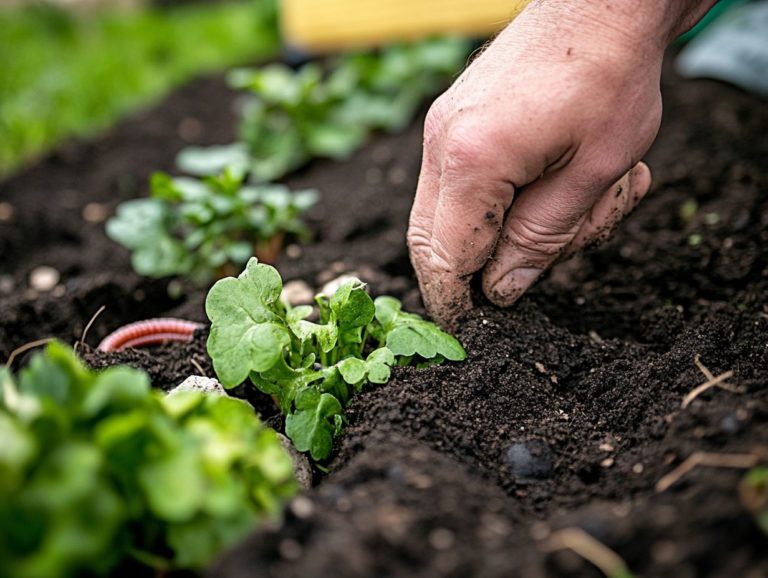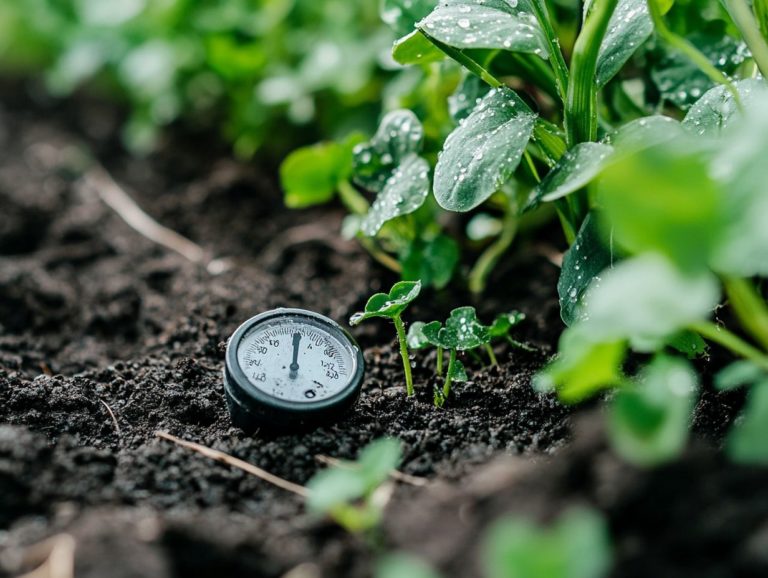5 Essential Components of Healthy Soil
Healthy soil serves as the cornerstone for flourishing plants and vibrant ecosystems, playing an essential role in your food systems and the overall well-being of the environment.
By grasping the five vital components organic matter, nutrients, microorganisms, pH balance, and soil structure you empower yourself to cultivate soil that is not only richer but also more productive. Understanding these components shows why healthy soil matters and provides practical strategies to enhance its quality.
Let s dive into the amazing world of soil and discover its secrets!
Contents
Key Takeaways:
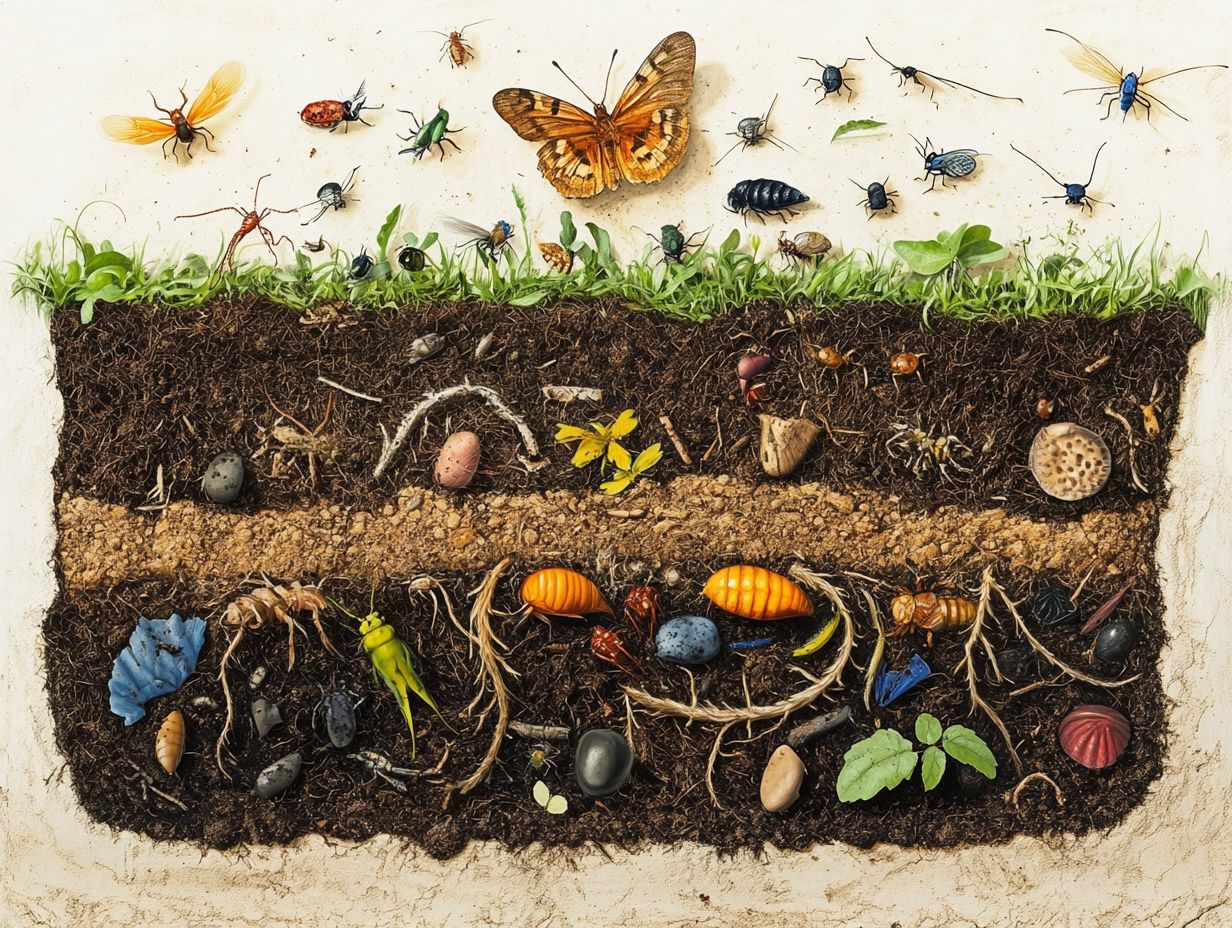
- Organic matter is crucial for healthy soil, providing essential nutrients and improving soil structure.
- Microorganisms play a vital role in maintaining a balanced pH level and nutrient availability in the soil.
- Testing soil health and regularly improving it through practices like crop rotation and composting can greatly benefit plant growth and prevent the consequences of unhealthy soil.
1. Organic Matter
Organic matter is the cornerstone of healthy soil. It enhances nutrient availability, boosts water retention, and cultivates a thriving ecosystem of soil microorganisms.
These factors all support robust plant growth and agricultural productivity.
Experts like Kaitlyn Ersek highlight the significance of organic matter in nutrient cycling, as it enables the breakdown of complex organic compounds into nutrients that plants can readily absorb. This process not only elevates soil fertility but also improves soil structure by promoting aggregation, which enhances aeration and allows for better root penetration.
Holganix, LLC highlights how organic matter is crucial in optimizing water management capabilities. By increasing the soil’s capacity to retain moisture, it reduces the need for irrigation and lessens the impact of drought conditions. Therefore, incorporating organic matter into your conservation practices emerges as an essential strategy for sustainable agriculture.
2. Nutrients
Essential nutrients like nitrogen, phosphorus, potassium, calcium, and sulfur are crucial for maintaining soil quality and play a direct role in the nutrient cycling process that supports your plants and fosters healthy agricultural landscapes.
Each nutrient has its role in soil health. Nitrogen is vital for protein synthesis and overall plant vigor, while phosphorus boosts root development and flower formation. Potassium helps with water retention and disease resistance, calcium contributes to improved soil structure, and sulfur is important for forming essential amino acids.
You ll find these nutrients in common sources such as organic matter, mineral deposits, and fertilizers, which highlight their significance in assessing soil health. When these nutrients are available in balanced amounts, they not only nurture a diverse microbial ecosystem but also greatly enhance food production, paving the way for sustainable agricultural practices.
3. Microorganisms
Soil microorganisms, such as bacteria, fungi, and protozoa, are critical players in the soil ecosystem, facilitating nutrient cycling, enhancing soil health, and promoting plant growth through their myriad activities, including decomposition and nitrogen fixation.
These tiny but mighty organisms significantly contribute to soil biodiversity by forming complex relationships within the ecosystem. For instance, bacteria are essential in breaking down organic matter, releasing vital nutrients like phosphorus and potassium that plants can easily absorb.
Fungi, on the other hand, form symbiotic partnerships with plant roots, boosting water absorption and nutrient uptake. Meanwhile, protozoa regulate bacterial populations, maintaining a balanced microbial community that nurtures a healthy soil environment.
Together, these microorganisms create a thriving ecosystem that not only supports plant growth but also ensures resilience against diseases and environmental stressors. This ultimately enhances agricultural productivity and sustainability, making their role in the soil ecosystem truly invaluable.
4. pH Balance
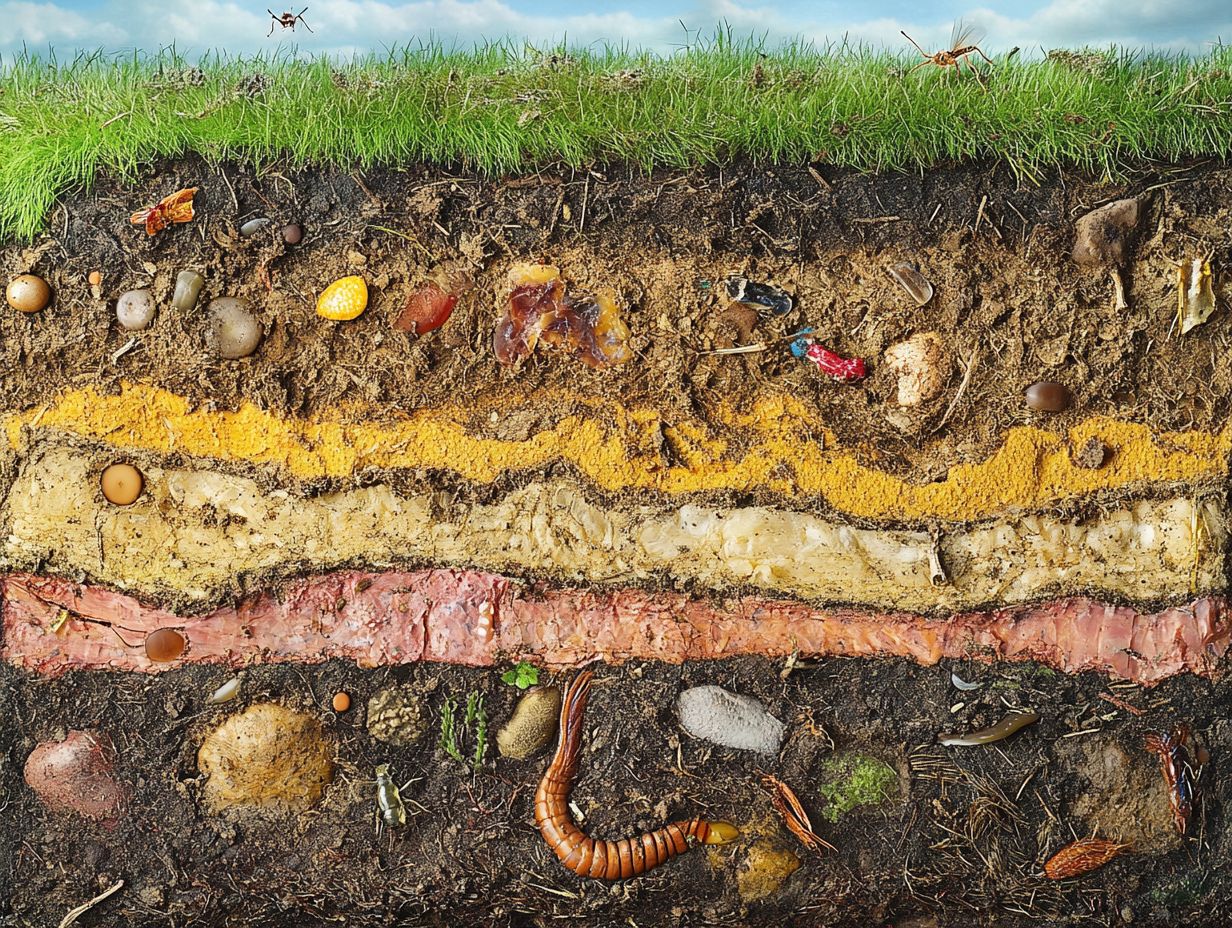
Maintaining the proper pH balance in your soil is crucial for ensuring optimal nutrient availability and overall soil health. This balance affects how nutrients cycle and how microbes in the soil work.
When your soil s pH level is just right, beneficial microorganisms thrive. These tiny allies effectively break down organic matter and enrich the nutrient pool available to your plants. If the balance is off, plants may struggle to access essential nutrients like phosphorus and nitrogen.
To assess your soil s pH, use simple methods like pH meters or test kits for quick insights. If adjustments are needed, techniques like adding lime to raise pH or sulfur to lower it can improve your soil quality. This supports a robust ecosystem, setting the stage for vibrant plant growth.
5. Soil Structure
Soil structure refers to how soil particles are arranged and the spaces between them. It is vital for soil quality, water management, and supporting diverse organisms, from plant roots to beneficial microorganisms.
Different types of soil structures granular, blocky, and platy each have distinct characteristics that influence soil health. Granular structures excel in providing aeration and infiltration, allowing water to nourish deeper roots. Blocky structures promote stability and help reduce erosion, while platy soil can hinder root growth and limit water retention.
Understanding these variations is essential for anyone interested in sustainable land management. Good soil structure leads to better conditions for plants to grow and enhances nutrient accessibility, ultimately improving agricultural productivity.
Why Is Healthy Soil Important?
Healthy soil is the foundation of our ecosystems, playing a critical role in food production, supporting biodiversity, and maintaining ecological balance. Implementing soil conservation practices is essential for fostering sustainable agricultural landscapes and ensuring environmental health.
Soil serves as a reservoir for vital nutrients and water, allowing crops to flourish while capturing carbon from the atmosphere an essential mechanism in the fight against climate change. Healthy soil creates a thriving habitat for countless organisms, nurturing rich biodiversity vital for pollination and pest control.
Prioritizing robust soil health enhances yields and cultivates resilient agricultural systems that rely less on chemical inputs. Investing in soil conservation secures food supplies and paves the way for a more sustainable future for our planet.
How Does Healthy Soil Benefit Plant Growth?
Healthy soil plays a crucial role in your plants’ growth by supplying essential nutrients, managing water efficiently, and fostering a thriving community of soil microorganisms. These allies enhance nutrient uptake and promote strong root development.
The connection between soil health and plant vitality is significant. Healthy soil directly impacts root health and overall growth. Rich organic matter acts like a sponge, retaining moisture and providing a habitat for beneficial microbes that convert nutrients into forms your plants can easily absorb.
These microorganisms create a symbiotic environment, empowering plant roots to explore the soil effectively and access vital elements like nitrogen and phosphorus. This balance ensures your plants remain well-nourished and resilient against diseases, enabling them to flourish even in challenging conditions.
What Are the Consequences of Unhealthy Soil?
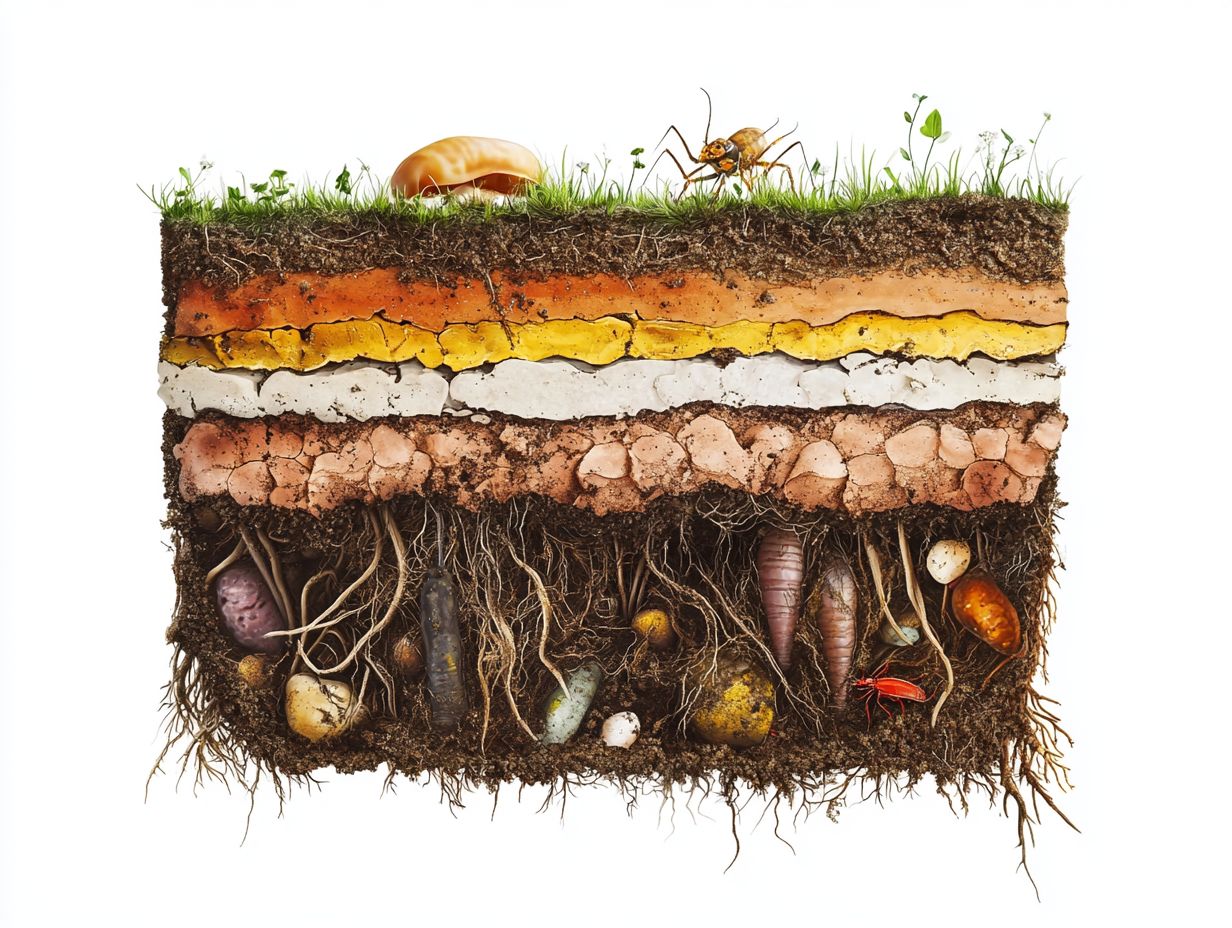
Unhealthy soil can lead to serious issues like nutrient depletion, soil contamination, and a decline in soil health. This results in lower agricultural productivity and a compromised ecosystem.
Various factors contribute to these challenges, including industrial pollution, excessive chemical use, deforestation, and unsustainable farming practices. Soil health deterioration disrupts the balance of tiny organisms and minerals, hurting crop yields and sometimes making land unsuitable for farming.
This degradation threatens food security and poses risks to our environment. It contributes to water pollution and a decline in biodiversity. Regular soil health assessments are vital. They help monitor quality and guide effective management practices, ensuring soil remains a sustainable resource for generations to come.
How Can One Improve the Health of Their Soil?
Improving the health of your soil requires you to embrace effective conservation practices, utilize organic materials, and manage your soil resources wisely. This approach enhances soil structure, nutrient availability, and the activity of beneficial organisms.
To achieve these objectives, consider adopting specific techniques like increasing the organic matter content through the application of compost or planting cover crops. Crop rotation is another powerful tool; it breaks disease cycles and enhances nutrient cycling, making your soil more resilient to climatic changes.
By minimizing soil disturbance with no-till or reduced tillage practices, you ll preserve soil structure and promote beneficial organisms. Sustainable methods lead to healthier ecosystems, ultimately resulting in improved crop yields and a more balanced ecological landscape.
What Are the Different Types of Soil and Their Characteristics?
Understanding the various types of soil and their characteristics is essential for effective land management. These soil types significantly influence soil quality, nutrient availability, and the suitability for different plants and agricultural practices.
Each soil type be it sandy or clayey has its own unique texture, composition, and physical properties. Sandy soils drain quickly due to their larger particles, often leading to lower nutrient retention. In contrast, clay soils are dense and retain moisture remarkably well, though they can become compacted, which can make it hard for plants to grow.
The distinctions among these soil types become clearer when using the soil texture triangle. This valuable tool visually categorizes soil based on the proportions of sand, silt, and clay.
By employing this diagram, you can more accurately identify soil types and tailor your agricultural practices to optimize plant health and productivity.
How Can One Test the Health of Their Soil?
Testing the health of your soil is crucial for understanding nutrient content, tiny organisms in the soil, and overall soil quality. This knowledge gives you the power to make informed decisions on how to enhance and maintain soil health.
You can assess your soil conditions using various methods and tools. Laboratory analysis is a highly reliable option, offering detailed reports on your soil’s composition and any potential limitations. If you prefer a hands-on approach, DIY testing kits are readily available, allowing you to quickly evaluate pH and nutrient levels right at home.
Regular evaluations assist in creating tailored fertilization plans and promote sustainable land management practices. By engaging in these assessments, you ensure your soil remains productive over time, ultimately benefiting both the environment and your agricultural outputs.
Frequently Asked Questions
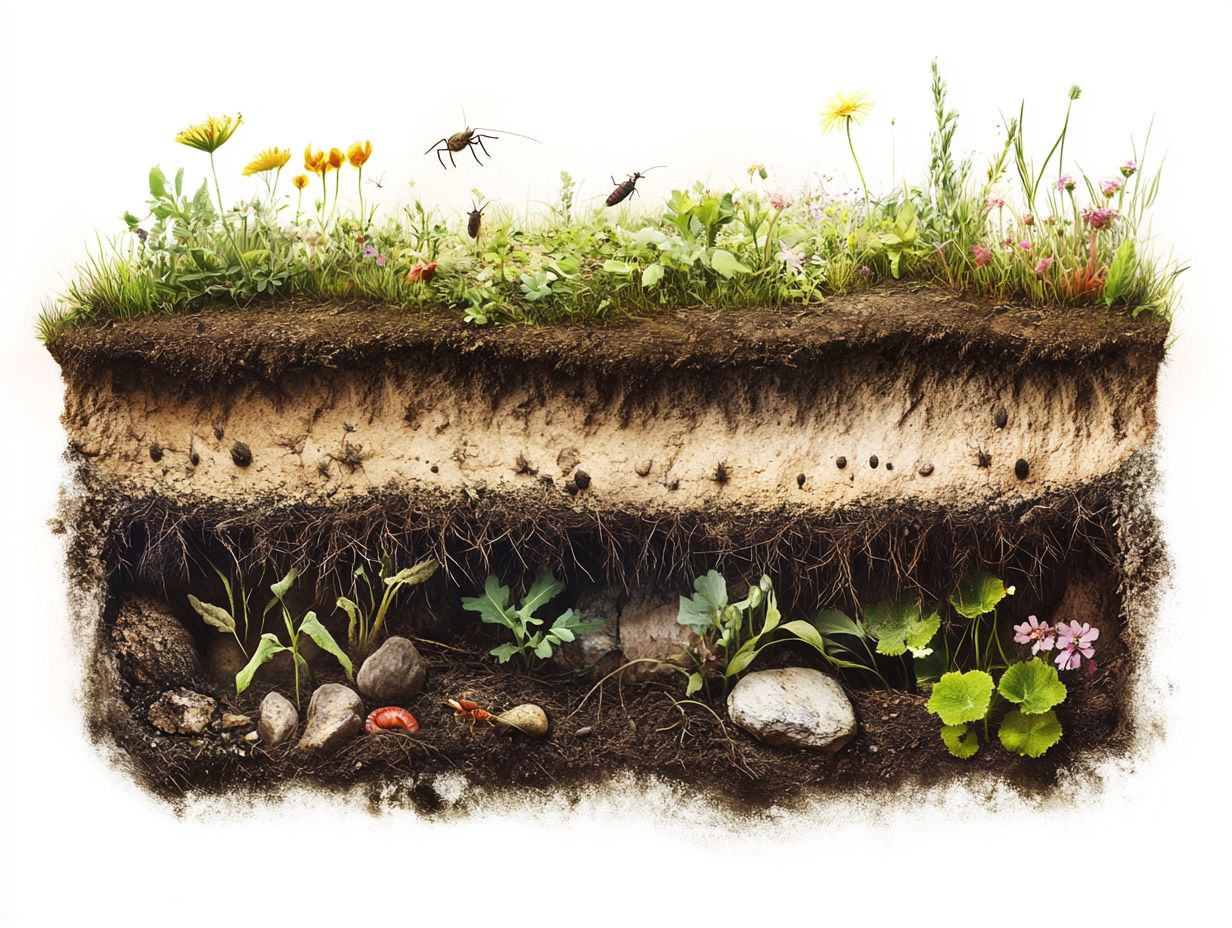
What are the 5 essential components of healthy soil?
Healthy soil has five key components: minerals, organic matter, water, air, and microorganisms.
Why are minerals important for healthy soil?
Minerals give plants the food they need to grow, like nitrogen, phosphorus, and potassium.
How does organic matter contribute to healthy soil?
Organic matter improves soil structure. It also retains moisture and feeds microorganisms.
Why is water necessary for healthy soil?
Water is crucial! It carries essential nutrients right to the plant roots and helps break down organic matter.
How does air impact the health of soil?
Air in the soil is vital for root breathing. It also supports beneficial microorganisms.
What role do microorganisms play in healthy soil?
Microorganisms are tiny living things that break down nutrients. They also help protect plants from harmful pathogens.

